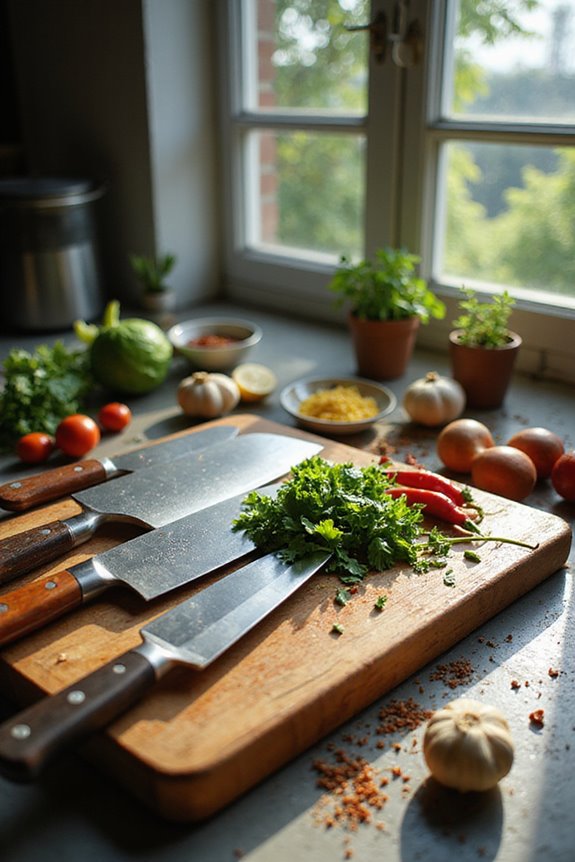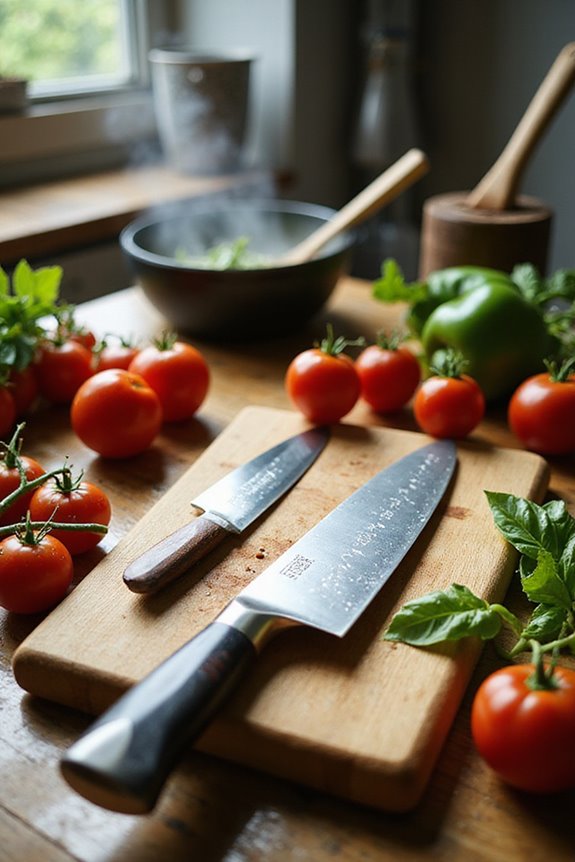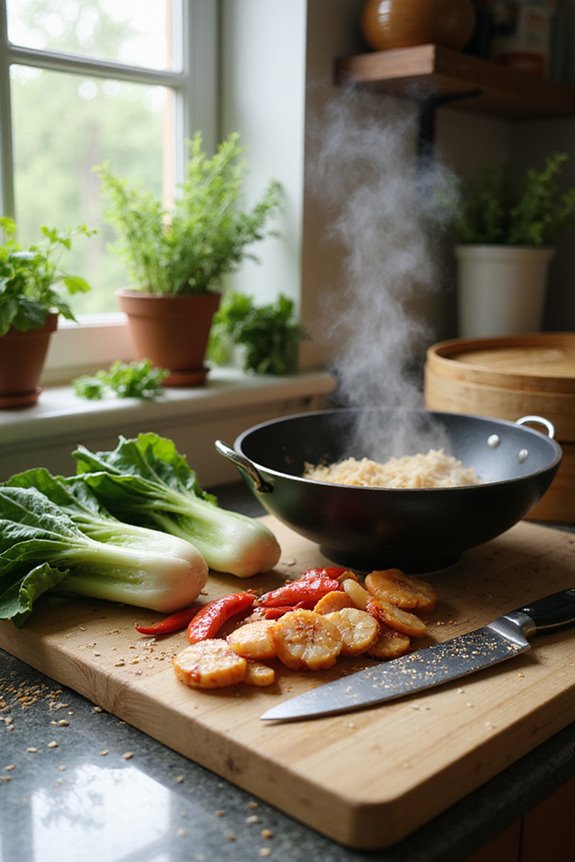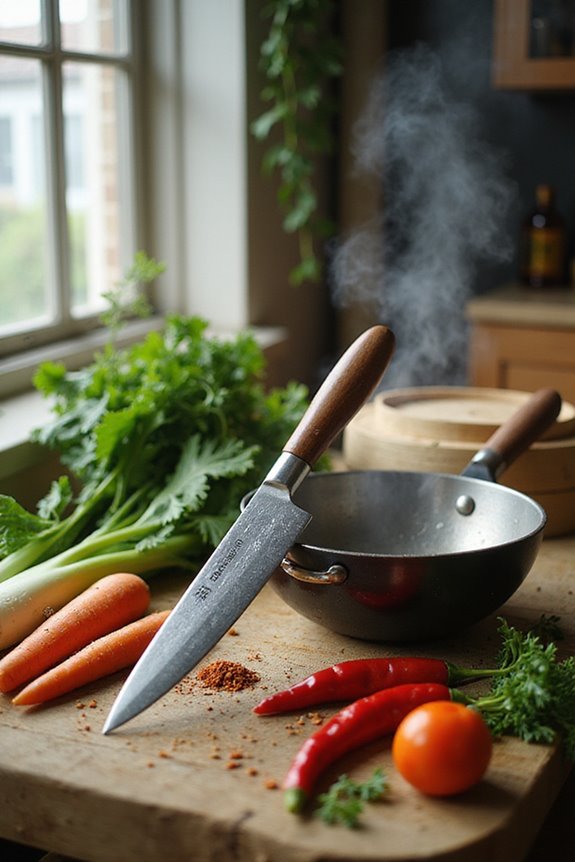As an Amazon Associate, we earn from qualifying purchases. Some links may be affiliate links at no extra cost to you. Although our opinions are based on curated research, we haven't used these products. Articles generated with AI.
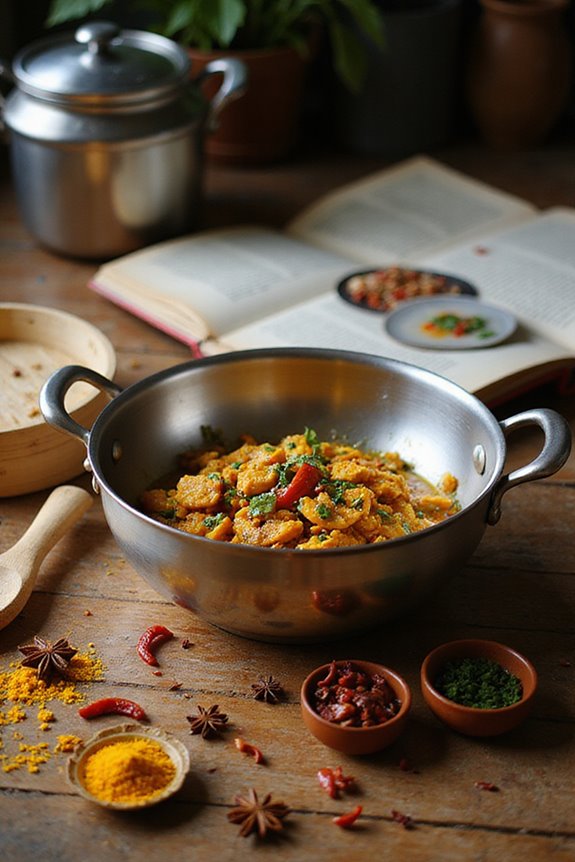
The 5 Best Modern Asian Fusion Cookbooks to Elevate Your Culinary Skills
If you’re looking to elevate your cooking, consider these five modern Asian fusion cookbooks: “Momofuku” for inventive Asian cuisine, “China Modern” for health-focused, accessible recipes, “Modern Asian Baking at Home” for delightful treats, “Easy Asian Cookbook” for quick, diverse meals, and “The Modern Art of Chinese Cooking” for authentic techniques. Each book blends traditional flavors with innovative approaches, making your culinary journey exciting and approachable. You’ll discover more insights and practical tips as you explore further.
Key Takeaways
- Momofuku: A Cookbook teaches modern Asian techniques with an emphasis on fresh ingredients and authenticity, perfect for adventurous cooks seeking creativity.
- China Modern offers simple, healthy fusion recipes with engaging anecdotes, making it ideal for singles or couples looking for accessibility in cooking.
- Modern Asian Baking at Home provides a variety of sweet and savory recipes, blending modern twists with cultural insights, great for home bakers.
- Easy Asian Cookbook features over 100 takeout favorites made simple, including dietary options, catering to busy individuals wanting flavorful meals.
- The Modern Art of Chinese Cooking delivers comprehensive guidance on authentic techniques, ideal for those wanting to master Chinese cooking fundamentals.
Momofuku: A Cookbook
If you’re an adventurous home cook enthusiastic to immerse yourself in the world of modern Asian cuisine, “Momofuku: A Cookbook” is an excellent choice. This book offers a narrative that reflects David Chang’s culinary journey, presenting not just recipes but a philosophy that encourages creativity. While engaging with his renowned pork bun recipe, you might encounter challenges, such as ingredient discrepancies. Expect long cooking times; this is essential for authentic flavor, especially in dishes like ramen. Don’t hesitate to visit local Asian markets for fresh components. Immerse yourself, experiment, and embrace the innovative spirit of Chang’s cuisine for rewarding results.
Best For: Adventurous home cooks looking to explore modern Asian cuisine with a creative culinary philosophy.
Pros:
- Unique narrative: Offers insights into David Chang’s culinary journey and innovative techniques.
- Authentic flavors: Emphasizes time-consuming processes that yield rich and genuine taste experiences.
- Ingredient guidance: Recommends sourcing fresh ingredients from Asian markets for improved results.
Cons:
- Recipe challenges: Some recipes may present discrepancies in measurements and cooking methods.
- Long cooking times: Many dishes require extensive preparation, which might deter casual cooks.
- Serving sizes: Recipes yield large portions, which may not suit smaller households or casual dining.
China Modern: 100 Cutting-edge, Fusion-style Recipes for the 21st Century
Sale
China Modern: 100 Cutting-edge, Fusion-style Recipes for the 21st Century
- Used Book in Good Condition
- Huang, Ching-He (Author)
- English (Publication Language)
“China Modern: 100 Cutting-edge, Fusion-style Recipes for the 21st Century” is an ideal choice for home cooks who want to explore innovative and accessible ways to integrate Asian flavors into their meals. Authored by Ching-He Huang, this cookbook features simple recipes using eight basic ingredients, making your culinary journey approachable. With a focus on health, you’ll find balanced dishes alongside lighter options. Each recipe serves two, perfect for singles or couples. Engaging anecdotes and cooking techniques keep you connected to the food. While some finished dish photos are missing, the vibrant layout and engaging content still inspire excitement in the kitchen.
Best For: Home cooks looking to explore innovative Asian flavors through simple and accessible recipes.
Pros:
- Recipes are straightforward and primarily use eight basic ingredients, making them easy to prepare.
- Focus on health with a balance of indulgent and lighter dishes, appealing to those mindful of their diet.
- Engaging anecdotes and cooking techniques enhance the connection to the recipes and inspire creativity in the kitchen.
Cons:
- Some finished dish photographs are missing, which may hinder understanding of the expected end results.
- Recipes are sized for two servings, which may not cater to larger households or gatherings without adjustments.
- A lack of extensive variety in available ingredients could limit some home cooks based in rural areas.
Modern Asian Baking at Home: Essential Recipes for Milk Bread, Mochi, Mooncakes, and More
Sale
Modern Asian Baking at Home: Essential Sweet and Savory Recipes for Milk Bread, Mochi, Mooncakes,...
- Hardcover Book
- Lieu, Kat (Author)
- English (Publication Language)
For anyone passionate about baking and enthusiastic to explore the delightful world of Asian flavors, “Modern Asian Baking at Home” stands out as an ideal choice. This cookbook presents essential recipes like milk bread, mochi, and mooncakes, all with clear instructions suitable for every skill level. You’ll appreciate how personal stories enrich each recipe, fostering a deeper connection to the ingredients and techniques. Stunning visuals paired with detailed guides on Asian ingredients elevate your experience. While some modern twists may surprise traditionalists, this book lays a solid foundation, encouraging experimentation and helping you create authentic Asian treats right at home.
Best For: Home bakers looking to explore Asian flavors through clear and accessible recipes.
Pros:
- Wide variety of recipes covering both sweet and savory traditional Asian treats.
- Personal stories and stunning visuals enhance the baking experience and foster cultural connection.
- Clear instructions make it suitable for bakers of all skill levels, from novices to experts.
Cons:
- Modern twists on traditional recipes may not appeal to purists seeking authenticity.
- Some recipes may not cater to every palate, leading to mixed reviews from readers.
- In-depth focus on certain ingredients might require specific sourcing, which can be a challenge for some.
Easy Asian Cookbook: 100+ Takeout Favorites Made Simple
Sale
Easy Asian Cookbook: 100+ Takeout Favorites Made Simple
- Fang, Kathy (Author)
- English (Publication Language)
- 186 Pages - 06/30/2020 (Publication Date) - Callisto (Publisher)
The “Easy Asian Cookbook: 100+ Takeout Favorites Made Simple” by Kathy Fang stands out as an excellent choice for home cooks seeking to replicate their favorite Asian takeout dishes without the complexity often associated with traditional recipes. This cookbook features over 100 diverse recipes, highlighting various Asian cuisines, including Filipino dishes. You’ll find accessible options that make cooking enjoyable, especially dishes like dandan mien and Italian sausage wontons. Although some readers wish for more photos, the inviting layout, helpful “Swap It” options, and dietary considerations guarantee this book remains a valuable tool. You’ll appreciate the cultural appreciation evident throughout.
Best For: Home cooks looking to enjoy diverse Asian takeout favorites with easy-to-follow recipes and accessible ingredients.
Pros:
- Easy and quick recipes suitable for busy lifestyles.
- Includes options for dietary restrictions, such as gluten-free.
- Inviting layout with helpful features like “Swap It” options and menu suggestions.
Cons:
- Some recipes lack accompanying photos, which may deter visual learners.
- Includes unexpected recipes, like those with hot dogs, which may not meet everyone’s expectations.
- Not a hardcore authentic cookbook, which may disappoint purists seeking traditional dishes.
The Modern Art of Chinese Cooking: Techniques and Recipes
Sale
The Modern Art of Chinese Cooking: Techniques and Recipes
- Used Book in Good Condition
- Tropp, Barbara (Author)
- English (Publication Language)
If you’re looking to immerse yourself in authentic Chinese cooking while enhancing your kitchen skills, “The Modern Art of Chinese Cooking: Techniques and Recipes” by Barbara Tropp is an indispensable resource. Tropp spent years in Taiwan, emphasizing that quality meal preparation takes time. Forget fast cooking; she recommends dedicating 40-50 minutes per dish for maximum flavor and nutrition. Though the book may seem intimidating at first, it’s filled with essential techniques and equipment advice, especially on cleavers. While it lacks photographs, the depth of knowledge makes it a crucial addition to anyone’s culinary library, turning cooking into an enjoyable, enriching experience.
Best For: Enthusiasts of authentic Chinese cooking seeking to develop their kitchen skills and knowledge.
Pros:
- In-depth guidance: Offers comprehensive techniques and cooking philosophies that enhance understanding of Chinese cuisine.
- Healthy focus: Encourages preparation of nutritious meals from scratch while highlighting the drawbacks of processed foods.
- Transformative advice: Provides valuable insights on essential kitchen tools, particularly cleavers, improving cooking efficiency and enjoyment.
Cons:
- Intimidating complexity: The detailed recipes may seem overwhelming for beginners with limited kitchen experience.
- Lack of visuals: Absence of photographs may disappoint some readers who prefer visual aids in cooking.
- Challenging layout: Recipes are not clearly delineated, potentially making them difficult to follow for some users.
Factors to Consider When Choosing an Asian Fusion Cookbook Modern
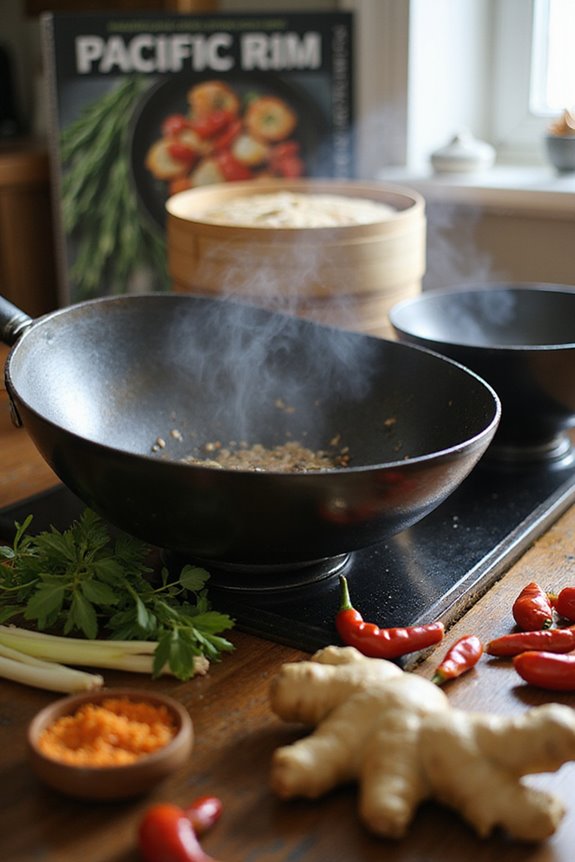
When you’re looking for the perfect Asian fusion cookbook, consider factors like recipe complexity and clarity to guarantee you can easily follow along. Think about ingredient accessibility and possible substitutions, especially if certain items are hard to find in your local store. Also, pay attention to cooking techniques, visual appeal, and portion sizes to make your meal planning enjoyable and efficient.
Recipe Complexity and Clarity
Choosing a modern Asian fusion cookbook involves careful consideration of recipe complexity and clarity, as these factors play a significant role in your cooking success. Look for cookbooks that provide straightforward, easy-to-follow instructions, especially if you’re a novice cook. Clarity is essential; precise measurements and unambiguous methods help you achieve the best results without confusion. If a recipe’s instructions are clear and engaging, cooking becomes an enjoyable experience rather than a chore. Additionally, consider cookbooks that share personal anecdotes or cultural context; this not only enhances understanding but also sparks excitement in the kitchen. Ultimately, a well-structured recipe can guide you seamlessly through the cooking process, elevating your culinary skills and confidence.
Ingredient Accessibility and Substitutions
A plethora of modern Asian fusion cookbooks prioritize ingredient accessibility, making them ideal for home cooks who want to experiment without the hassle of specialty shopping. Many of these books focus on basic ingredients that are easy to find in metropolitan areas, helping you locate what you need. They often provide substitutions to accommodate dietary restrictions, like vegetarian or gluten-free options, enhancing your culinary flexibility. Most also include straightforward instructions, ensuring even novice cooks can follow along. By highlighting common pantry staples alongside unique ingredients, they strike a balance that encourages experimentation. Finally, these cookbooks may offer sourcing suggestions for authentic ingredients, helping you achieve true flavors without compromising accessibility in your cooking journey.
Cooking Techniques and Tips
Selecting the right Asian fusion cookbook can greatly enhance your cooking journey, especially when you consider the cooking techniques and tips it offers. Look for cookbooks that emphasize simplicity in cooking methods, often using just eight basic ingredients to keep things accessible for all skill levels. Common techniques like quick stir-frying, steaming, and braising allow you to prepare flavorful dishes quickly without losing authenticity. Health-conscious options are a plus, balancing indulgent flavors with lighter cooking methods that avoid processed ingredients. Additionally, personal anecdotes and cultural stories can enrich your connection to the dishes. Finally, choose books that provide practical tips on ingredient substitutions, catering to your dietary preferences or seasonal availability.
Visual Appeal and Design
Visual appeal and design can greatly influence your experience with an Asian fusion cookbook. Many modern cookbooks feature stunning photography and thoughtful layouts that inspire your culinary journey. Look for engaging designs filled with vibrant colors, clean typography, and photographs that highlight finished dishes; these elements can truly elevate your confidence in the kitchen. However, be cautious, as some cookbooks might lack these visuals, making it difficult to understand what the final product should look like. A good cookbook will also include helpful components like cooking tips, ingredient glossaries, and thematic menu suggestions, which enhance your cooking experience. When personal stories accompany the recipes, you create a deeper connection to the dish, making cooking even more enjoyable.
Portion Sizes and Meal Planning
When choosing an Asian fusion cookbook, it’s important to contemplate portion sizes and meal planning options. Many cookbooks offer recipes sized for two servings, making them perfect for singles or couples. You can easily scale these recipes up for larger gatherings or meal prep. Additionally, look for suggested menus based on chapter themes, as they provide inspiration for cohesive dining experiences or themed meals. Consider options that emphasize quick preparation times, especially if you’re busy but still want to enjoy diverse flavors. Recipes that cater to dietary restrictions guarantee flexibility in meal planning, accommodating varied preferences. Finally, cookbooks with “Swap It” options allow you to adapt recipes based on your available ingredients, enhancing accessibility in meal preparation.
Cultural Authenticity and Respect
Cultural authenticity and respect are essential aspects to reflect upon in any Asian fusion cookbook, especially since the culinary landscape is rich and complex. When choosing a cookbook, consider the author’s cultural background and experiences; these factors contribute to capturing authentic representations of the cuisines. Look for titles that honor the origins of their recipes by providing context about cultural significance and traditional methods. A successful fusion balances innovation with tradition, honoring the flavors and techniques of original cuisines. Recipes should clarify ingredient substitutions and cooking techniques, ensuring respect for the essence of the dishes. Finally, read reviews from individuals familiar with the cuisine; their insights can guide you to cookbooks that genuinely respect culinary traditions.
Personal Anecdotes and Stories
Incorporating personal anecdotes and stories in modern Asian fusion cookbooks enriches your cooking experience by connecting you to the recipes on a deeper level. These tales often provide context and cultural significance, enhancing your appreciation for each dish. Many authors share family traditions, inspiring you to recreate authentic experiences in your own kitchen. Their culinary journeys illustrate how backgrounds influence their fusion of flavors and techniques, making complex cooking processes seem approachable. Relatable experiences demystify challenges, ensuring you feel confident while cooking. Plus, these narratives foster a sense of community, encouraging you to explore and share your culinary adventures. By choosing cookbooks with personal stories, you can create more meaningful meals that reflect both tradition and innovation.
Flexibility in Meal Options
Choosing the right modern Asian fusion cookbook involves considering flexibility in meal options, as this can greatly enhance your cooking experience. Look for cookbooks offering recipes sized for two servings, which are perfect for singles or couples, yet can easily scale for gatherings. Check for “Swap It” options and dietary considerations like gluten-free substitutes, allowing you to cater to diverse preferences. Straightforward recipes with accessible ingredients are essential for busy lifestyles, helping you whip up delicious meals quickly. Engaging content featuring personal anecdotes can inspire you to adapt recipes based on what’s in your pantry. Finally, suggested menus based on themed chapters streamline meal planning, making it effortless to create delicious themed dinners or quick weeknight meals.
Frequently Asked Questions
What Is the Difference Between Asian Fusion and Traditional Asian Cuisine?
Asian fusion blends different culinary traditions, creating unique dishes that combine flavors and techniques from various cultures. In contrast, traditional Asian cuisine sticks closely to its regional roots, emphasizing authentic ingredients and methods. For example, you might find sushi made with avocado and cream cheese in fusion dishes, while traditional sushi focuses solely on vinegared rice and fresh fish. Understanding these distinctions helps you appreciate the creativity of fusion while respecting traditional practices.
Are These Cookbooks Beginner-Friendly for Novice Cooks?
You’d think modern Asian fusion cookbooks would be gourmet challenges only for chefs, right? Surprisingly, many of them are perfect for beginners! They often feature straightforward recipes, step-by-step instructions, and accessible ingredients. You’ll find techniques that allow you to build confidence while experimenting with flavors and styles. Plus, the vibrant dishes inspire creativity, making cooking feel less like a chore and more like an exciting culinary adventure. So go ahead, plunge into!
How Can I Adapt Recipes for Dietary Restrictions?
To adapt recipes for dietary restrictions, first identify what ingredients need replacing. For example, if you’re gluten-free, substitute wheat flour with almond or coconut flour. Use alternative proteins like legumes or tofu for vegetarian diets. Think about the consistency and flavor; adjust spices to maintain taste. Keep experimenting, and don’t hesitate to combine different substitutes. Cooking’s about creativity, so try new combinations and enjoy the process while making it suitable for everyone’s needs.
What Cooking Tools Are Essential for Asian Fusion Cooking?
To excel in Asian fusion cooking, you’ll need a few essential tools. First, a high-quality cleaver for chopping, slicing, and dicing is vital. A non-stick wok guarantees even heat distribution while stir-frying, and an immersion blender is great for smooth sauces. Don’t forget a bamboo steamer for perfect dumplings and a rice cooker for fluffy rice. These tools will enhance your efficiency and elevate your dishes, making your cooking experience more enjoyable.
Where Can I Find Specialty Ingredients for These Recipes?
You can find specialty ingredients for Asian fusion recipes at local Asian markets, which often stock unique items like miso, lemongrass, and rice noodles. Online retailers also offer a wide variety, so check sites like Amazon or specialty grocery websites. Don’t forget to explore farmer’s markets for fresh produce—sometimes they have hard-to-find herbs and spices. With a little effort, you’ll gather everything needed to create delicious dishes that wow your guests.






